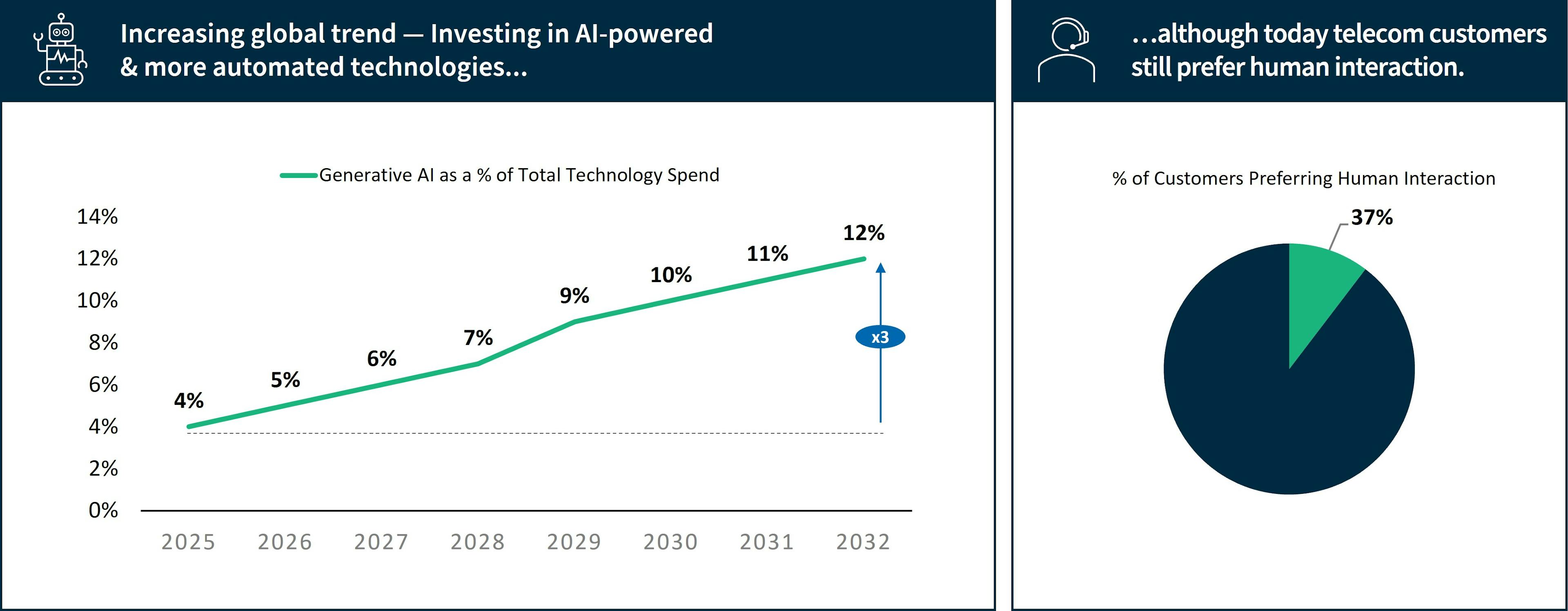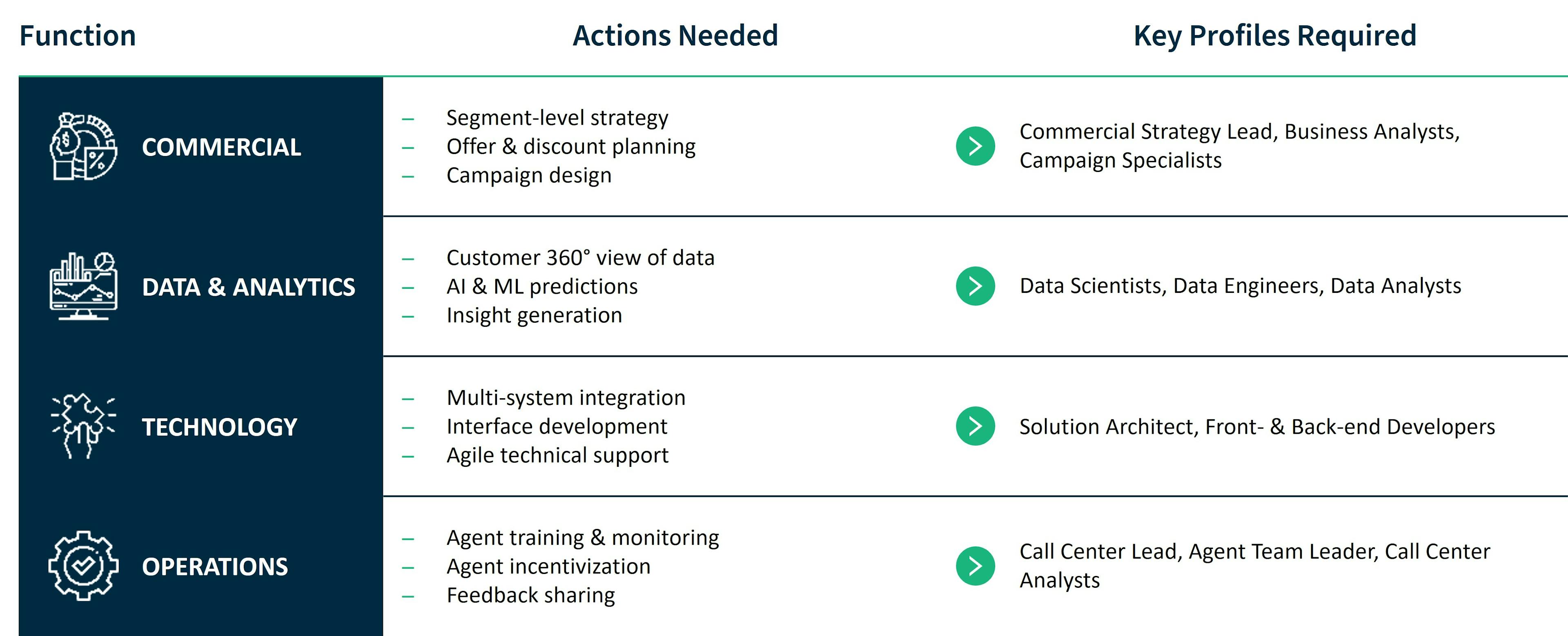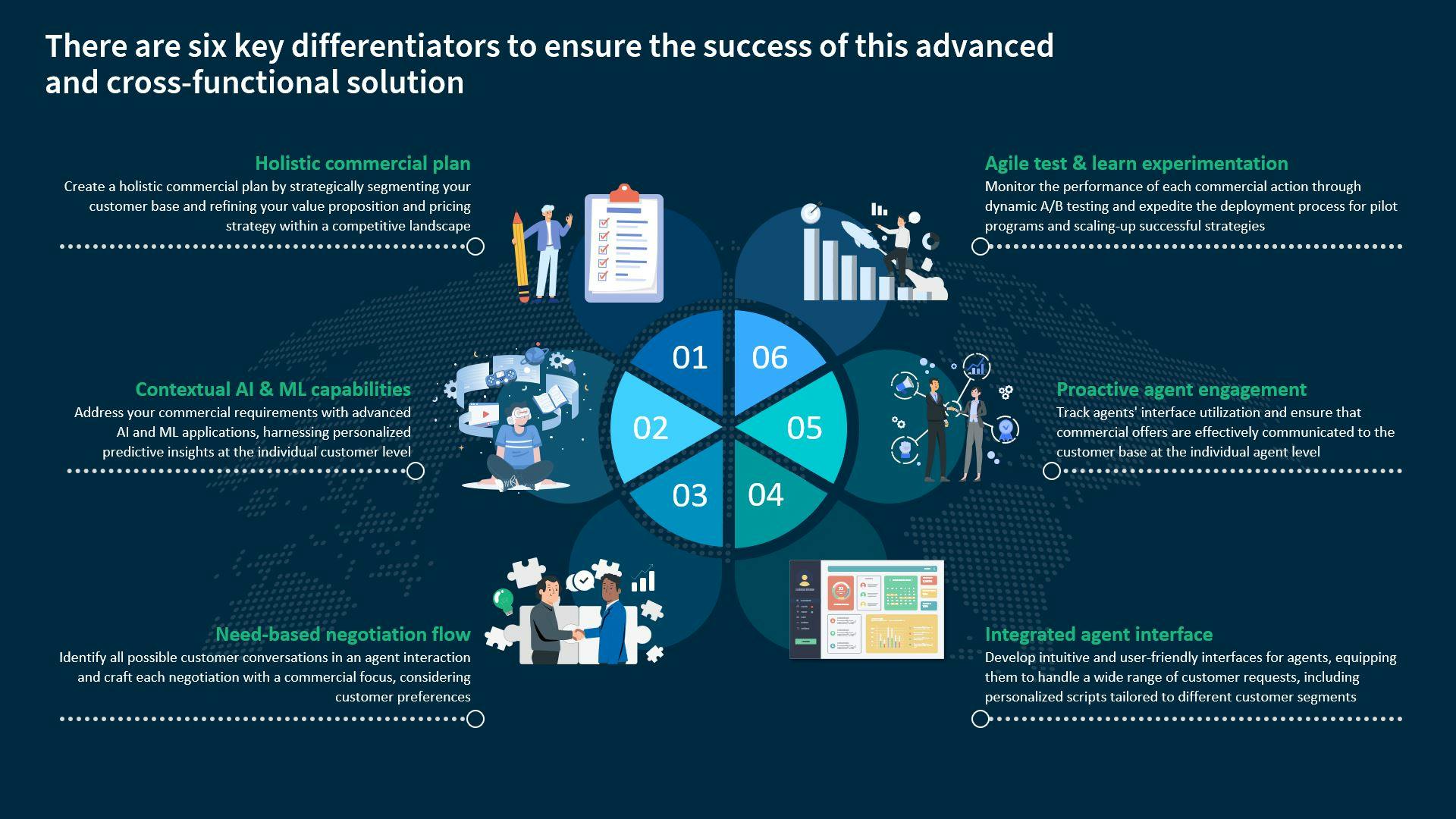Orchestrating AI Applications and Human-led Commercial Activities
Orchestrating AI Applications and Human-led Commercial Activities
In today’s dynamic business landscape, digitization and AI are at the forefront, captivating both technology companies and telecom operators. These investments are driven by evolving industry standards and customer demands.
This shift to automation and advanced technology is a long-term endeavor, where human engagement through call centers and retail outlets remains critical.
This shift requires a hybrid approach that blends machine-driven automation with human interaction to maximize business value. Telecom operators face challenges in optimizing call center operations, particularly in meeting customer demands for contract renewal discounts while maintaining top-line revenue.
1. The Challenge
In the contemporary business landscape, digitization and generative AI (Artificial Intelligence) are increasingly capturing the spotlight, attracting significant interest not only from technology companies but also from telecommunications operators. The primary reason for substantial investments in digitization and AI-powered capabilities originates from the ever-evolving industry standards and dynamic shifts in customer needs. Yet it’s crucial to acknowledge that this transition is a long-term endeavor to embrace fully automated and cutting-edge technologies. Throughout this transformation, the majority of business operations, including commercial customer interactions, will continue to rely on human engagement facilitated through call centers or traditional retail stores. Consequently, this scenario compels organizations to seek a hybrid approach that effectively combines machine-driven automation with genuine human-led operations, optimizing commercial benefits by leveraging the strengths of both.

In this context, telecommunication operators across the world are dealing with challenges in realizing the full potential of implemented futuristic technologies within their call center operations. As customers reach out seeking more substantial discounts at the time of contract renewal, companies often face challenges in harnessing the full potential of AI and ML-powered (Machine Learning) systems to efficiently leverage data-driven insights related to customer preferences, price sensitivity, etc. Additionally, when call center agents are granted a certain level of freedom in discount negotiations, this situation will lead to an inevitable erosion of top-line revenue.
2. The Solution
Given the complexity of the challenge and continuity of organizational transformation initiatives, FTI Delta’s crafted methodology empowers clients to achieve success in this cross-functional effort. Our solution seamlessly orchestrates strategic commercial logic and AI-powered capabilities with a fully integrated and user-friendly interface to optimize the output of commercial negotiations between agents and customers. Its flexibility is a standout feature, allowing it to be hosted either on our secure cloud domains or on the client’s platforms.
Our focal point revolves around delivering customized solutions within four key organizational functions, elaborated as follows:

Customizing solutions based on the unique conditions of each organization is paramount. Every company operates at a different level of maturity across the various functions mentioned above. This diversity significantly influences the design of the solution. Additionally, it’s crucial to embrace that this is an evolving process. Advancing through maturity levels escalates the complexity and effort invested in the solution, resulting in a substantial impact. The objective is not necessarily to advance equally across all maturity dimensions, nor is it obligatory to achieve parity in maturity levels. Rather, each company is tasked with defining its target operating model and selecting the underlying technologies that align most effectively with its unique context and strategic objectives. In essence, the pursuit of maturity is a customized journey, allowing businesses the flexibility to prioritize and optimize specific dimensions based on their individual needs and long-term goals.

3. Key Success Factors
Leveraging our vast expertise on the subject, we have distilled six key takeaways to drive measurable top-line impact in this cross-functional initiative. Considering the complex nature of telecom organizations, these six points are crucial for minimizing inefficiencies and maximizing benefits within multidisciplinary task forces. Each item below has been carefully crafted to ensure alignment with the industry’s unique demands and evolving challenges.

1. Holistic commercial plan
To start, strategically categorizing the customer base into actionable segments will enable the organization to utilize their distinctive characteristics with key commercial data points. This segmentation lays the groundwork for a more personalized and effective approach to tailoring the value proposition for each segment. Precisely fine-tune the offer and pricing structure to align with the specific needs of each customer segment, elevating its attractiveness and relevance.
2. Contextual AI & ML capabilities
The key to success always lies in how effectively the data ecosystem fulfills commercial requirements. Our recommendation typically starts with gathering precise commercial requirements from all stakeholders and constructing a live customer-level data mart that encompasses essential data points for informed commercial actions. Subsequently the focus shifts to understanding the predictive and real-time capabilities necessary to set the system in motion. This phase requires a dedicated investment of time and effort from the team to develop commercially driven and explainable AI & ML models. These models are designed to predict churn risk, product propensity, downgrade risk and pricing elasticity at the customer level, forming the bedrock of a robust and effective system.
3. Need-based negotiation flow
When navigating potential negotiation scenarios, the organization must define its product portfolio comprehensively, anticipate various commercial moves that customers might consider, understand life-stage related customer needs and be aware of pricing capabilities within live systems. Based on these key elements, crafting an end-to-end decision tree per segment is highly crucial. Aligning commercial objectives with the strategic direction set by the decision-maker ensures a cohesive approach. For instance, a customer reaching out for retention purposes may be exploring options such as product downgrades or partial termination. Equipping agents with a structured conversation flow, complete with pre-set pricing and justifications, is essential to effectively address these diverse possibilities and persuade the customer.
4. Integrated agent interface
A critical aspect of the process involves establishing a clear, comprehensive and seamlessly integrated interface to empower agents in efficiently conducting customer negotiations aligned with the commercial strategy. It is essential to have dynamic scripts readily available for each customer, encompassing offers, pricing details, alternative options and rationales to effectively inform customers. As agents navigate negotiations and select preferred options, the back-end system should seamlessly and automatically execute the recommended commercial moves at the predefined pricing. This interface should be not only easy to follow by agents but also swiftly customizable to accommodate alternative commercial actions. Additionally, it should incorporate A/B testing features to enhance adaptability and effectiveness.
5. Proactive agent engagement
Once the entire system is ready for execution, the success of this mission hinges on how effectively agents utilize the platform. We advocate for a multilayered governance approach to guarantee that agents leverage the full capabilities of the solution. First, comprehensive training documentation and in-person introductory sessions should be implemented to equip agents with the necessary skills. Subsequently, the operations team leads should diligently monitor agent engagement daily or weekly, tracking individual metrics such as the number of customer searches, offers presented based on the tool’s recommendations, and customer acceptance rate. Last but certainly not least, a compelling incentivization program should be initiated to inspire agents to embrace and utilize the solution.
6. Agile test-and-learn experimentation
When it comes to this kind of complex system involving multidisciplinary teams in operations, the pivotal keys to success lie in agile learning and the ability to swiftly adapt the system. Piloting commercial actions at the appropriate level, matching high-performing agents with high-value customers and actively gathering feedback from agents on customer interactions are essential steps to enhance system performance in real time. Furthermore, proactively listening to actual conversations provides valuable insights. Adding another layer, any proposed commercial action or new pricing strategy should undergo rigorous A/B testing, and scaling up the action should occur only after conclusive proof of success.
